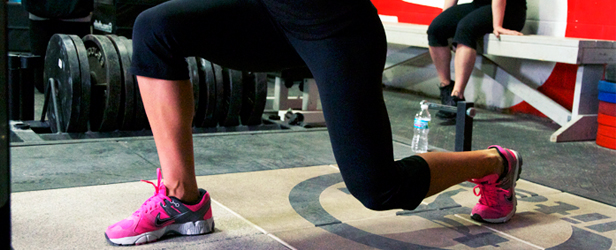
After college, I strength trained at a chiropractic rehabilitation facility for a few years. While there, I picked up a few helpful tips that I still use today when initiating static postural assessments for my athletes.
They are quick and easy and will provide you with a starting point, after which, more detailed assessments can be made. But first, let’s review why an athlete might be out of “alignment.”
Postural alignment issues could be caused by any of the following:
- Compensations—dysfunction or postural issues from faulty muscle length/tension relationships across the kinetic chain causing musculature to shutdown or be inhibited. These result in issues within the muscular, neural, fascial, and articular systems.
- The 23:1 rule—twenty-three hours a day of poor habits and short range movements can’t be overcome by one hour in the gym.
- Musculature imbalances—i.e. force couples (opposing parallel forces/muscle actions) unbalanced (Robertson and Hartman 2007).
- Congenital defects
- Subluxations
- Previous injuries resulting in scar tissue developments and mobility restrictions
- Flexibility/mobility issues
- Poor choices of footwear
Here are three quick and easy techniques to evaluate posture and alignment.
Evaluation Techniques
Technique 1: Relaxation before assessment
Before taking your static assessment, you must first make sure that the athlete is relaxed and not compensating to skew the test.
Have the athlete close his eyes, flex and tuck his chin down to his chest, and then extend his neck all the way back. Finally, have the athlete move back to neutral. After the athlete opens his eyes, the assessment can begin.
This technique relaxes (and resets) the stabilizers of the neck, and subsequently the shoulders, back, and hips to their normal standing position without tension or compensation. Alignment issues can then be more readily observed. Another great idea is to not tell the athlete that you are evaluating them! Quite often, athletes will want to “perform” well on their test so don’t tell them anything.
A variation to this technique involves having the athlete walk in place for 5–10 seconds to free up the ankles, knees, hips, and shoulders. Once complete, the athlete should come to rest where her feet feel comfortable and then proceed with the neck relaxation protocol mentioned above. Internal and external rotation of the feet will now be more readily observed.
Technique 2: Alignment grid
Note: For this technique, you’ll need several jump-stretch bands and a power cage. Technique 2 should also be preceded by Technique 1.
Chiropractors use a string alignment grid or posturometer to observe bilateral asymmetries of the head, shoulders, hips, knees, and spine. You’ll need three horizontally placed bands and one vertical band anchored at the bottom by a dumbbell and fixed in a power cage.
The posturometer is a metal box that the athlete will stand in. A string is moved to similar anatomical bilateral reference points posteriorly.
First band alignment
Move the first band, lining it up across the left and right bony reference points of the acromion.
Second band alignment
Move the second band, lining it up across the left and right bony reference points of the pelvic crest.
Third band alignment
Move the third band, lining it up across the left and right knee.
You should be looking for any and all of the following:
- Are the shoulders in line and level?
- Are the hips in line and level?
- Are the knees in line and level?
- Is the head shifted to the right or left?
- Are the ears level?
Bill Hartman also suggests using an advanced technique that utilizes a digital camera along with photo editing software so that straight lines can be drawn to note alignment issues.
Note: Pick up Cressey and Robertson’s Building the Efficient Athlete for further details.
Technique 3: Bilateral weight scales
How is the athlete loading his or her body between the right and left sides? Are they bilaterally symmetrical? Get two scales and line them up side by side. Have the athlete stand with one foot on each scale.
Notice any asymmetry between loading on the right to the left. If the right scale is heavy, does the athlete have an ankle, knee, or hip injury on the left side? Is his or her left hip weak? Or is the left foot in valgus due to poor footwear, lack of mobility, or Achilles tendon tightness, which will also push the athlete to the right?
Start working on improving postural alignment and muscle recruitment patterns by:
- Your visual assessments
o Athlete in motion
o Athlete static
· Balancing volume and intensity of movements (i.e. push/pull, flexion/extension, internal rotation/external rotation)
· Increase soft tissue work prior to primary workout or within additional recovery workouts to remove shortening or inhibited structures (fascia, muscles, etc.)
o Some tools include foam rollers, tennis balls, massage
· Ensure stability and integrity of potentially unstable kinetic segments (i.e. knees, lower lumbar, scapulae, GH joint)
o With isometrics, EQI, and full range of motion unilateral and compound movements
· Ensure mobility and recruitment across immobile kinetic segments with full range of motion movements (i.e. ankles, hips, thoracic spine region, scapulae, elbows, wrists, fingers)
o Utilizing thorough warm-ups and incorporating broad postures, movements, and various strength training modalities that engage the supporting and surrounding structures
These three tools can be added into your ongoing assessments for your athletes. As your athletes progress, so should your monitoring of physiological state, optimal alignment, function, and the affects on their performance.








